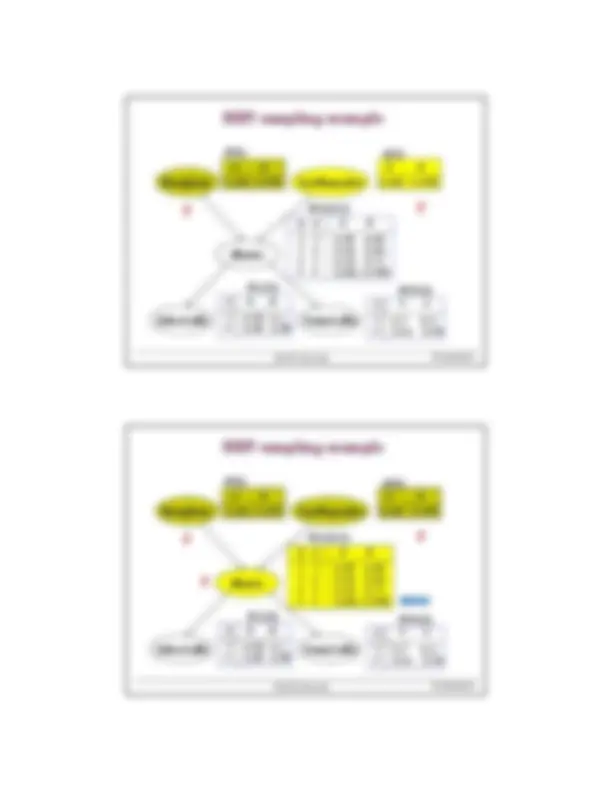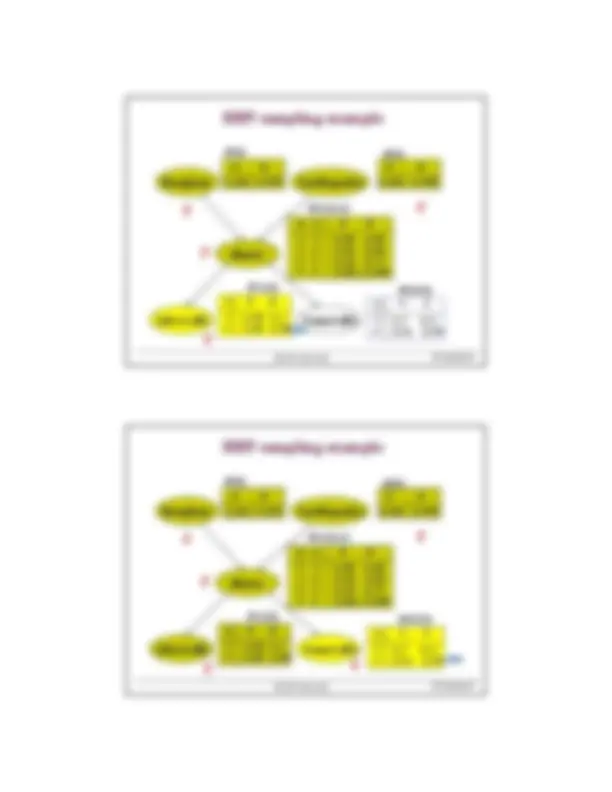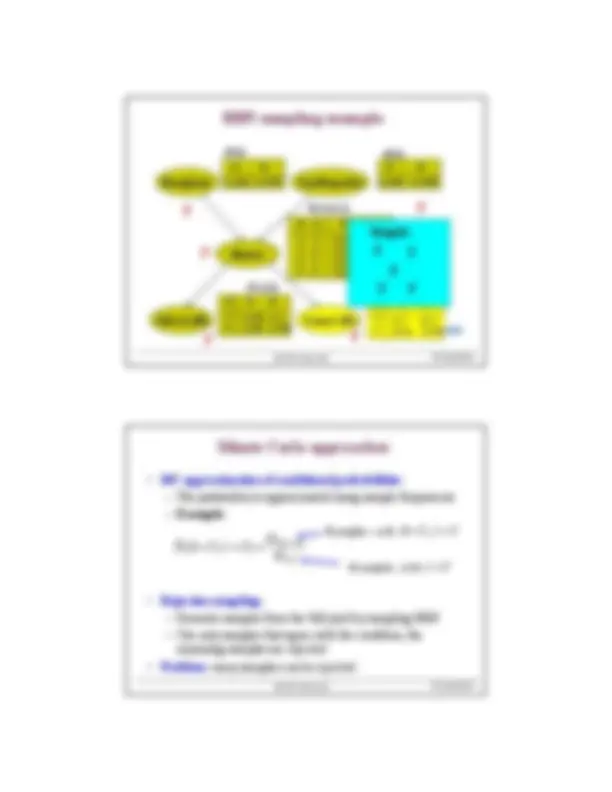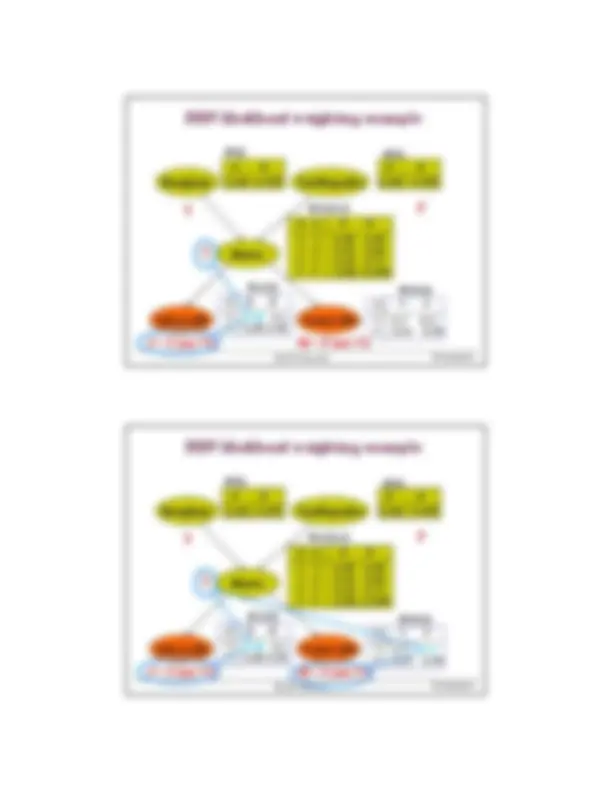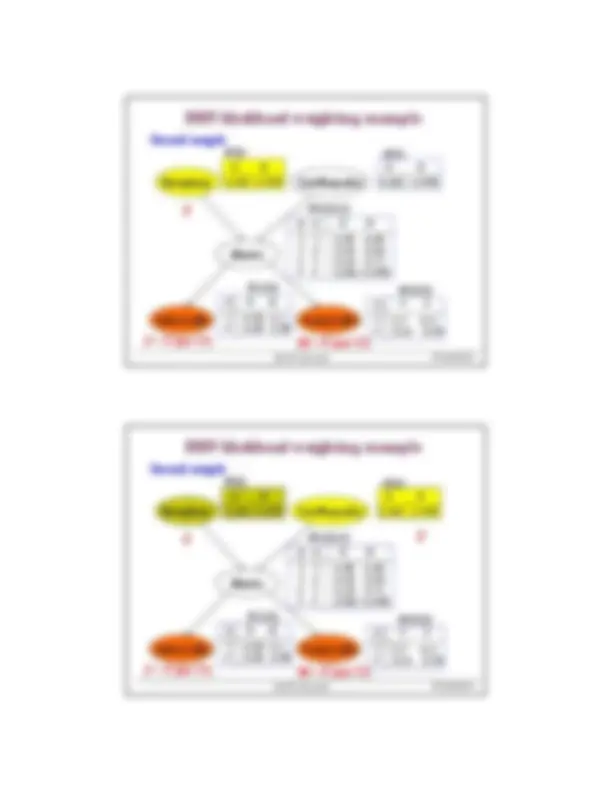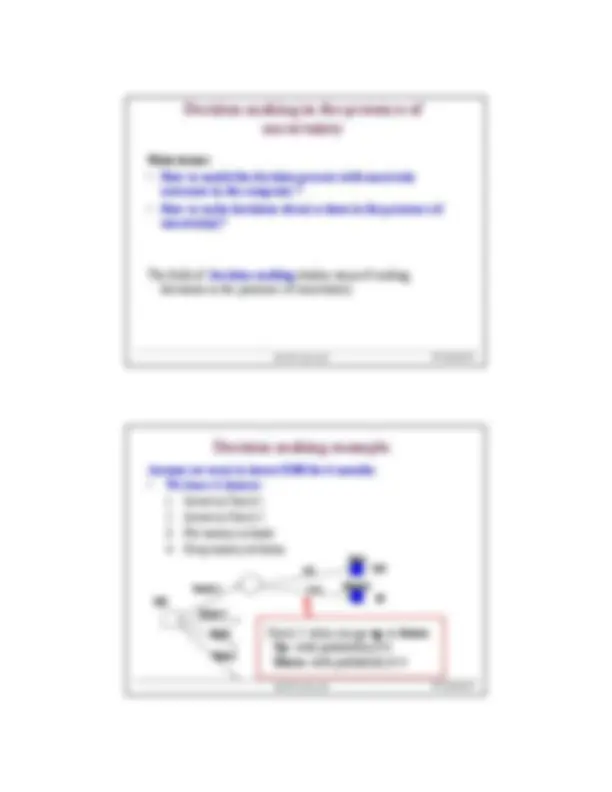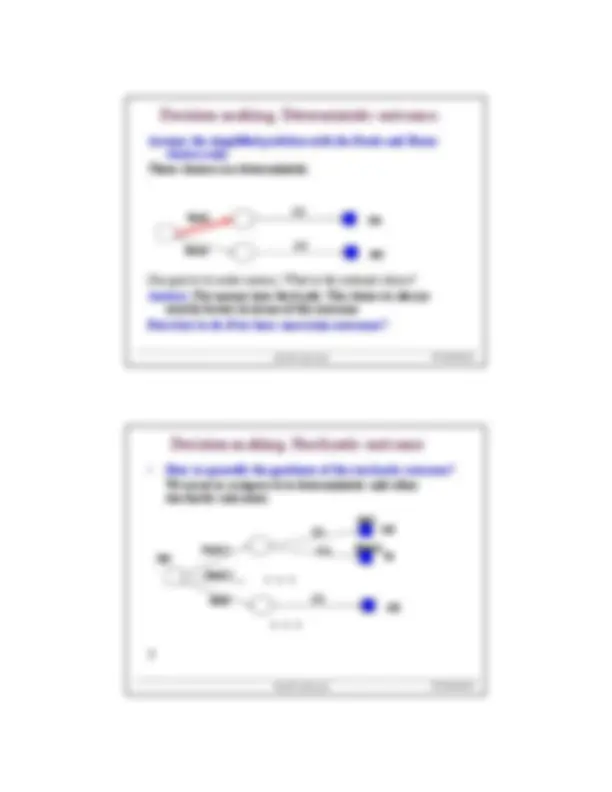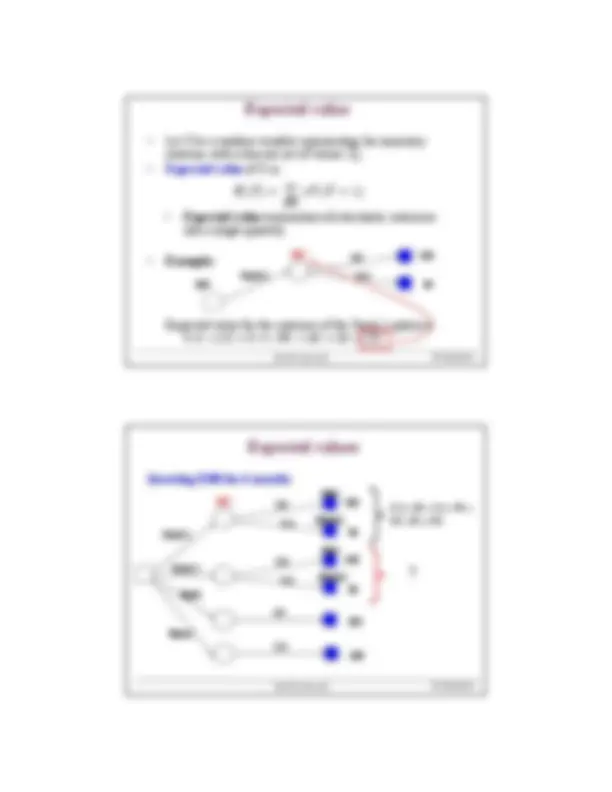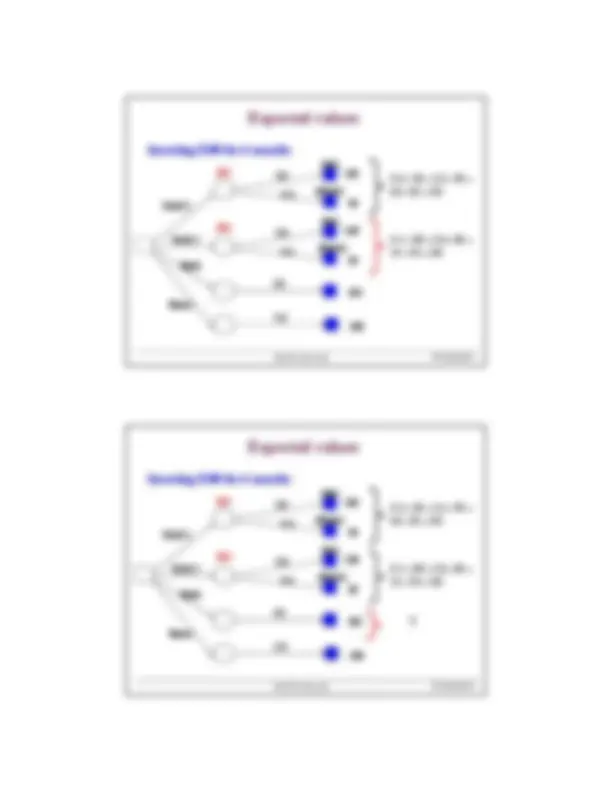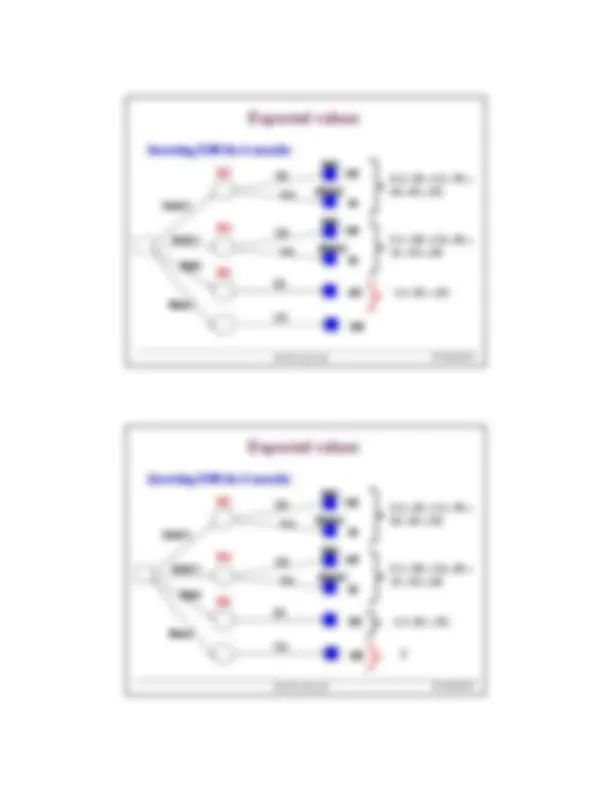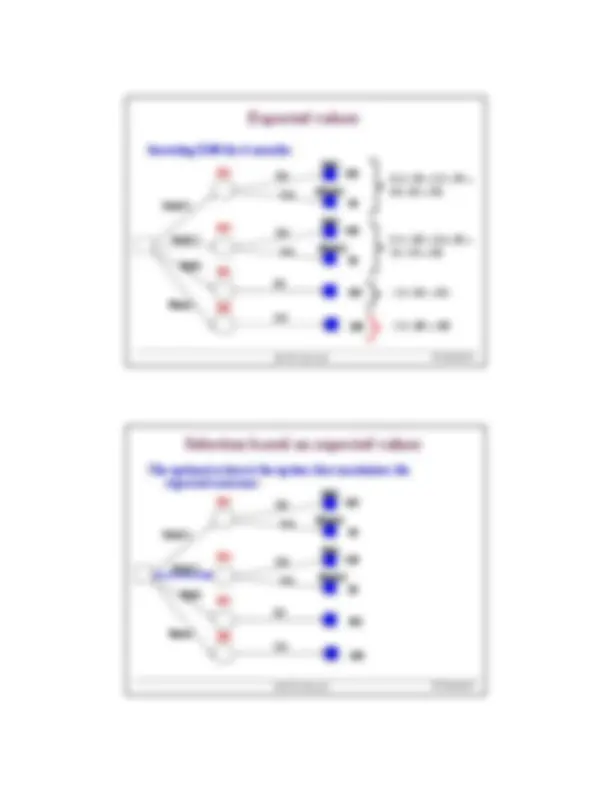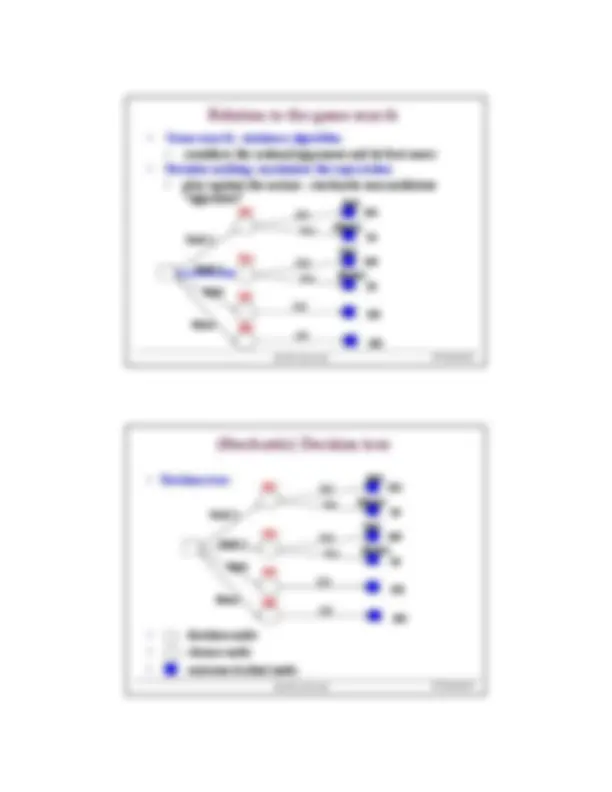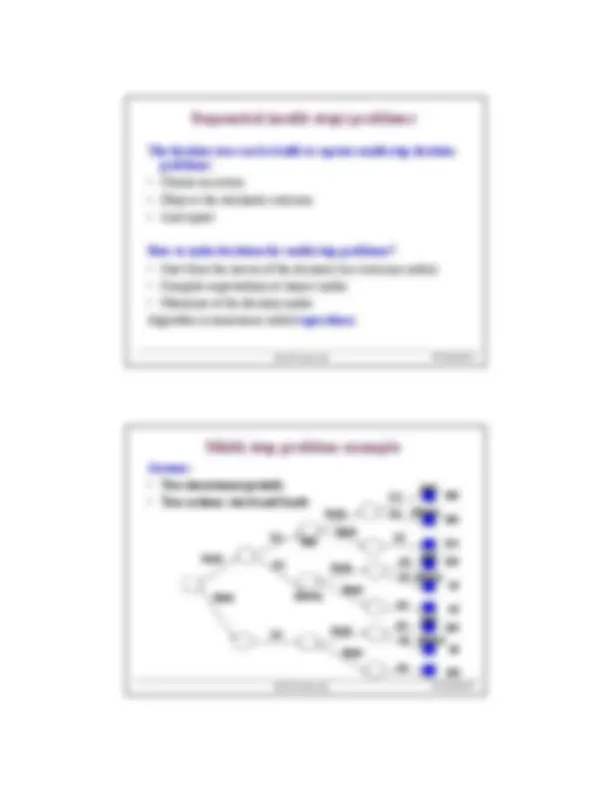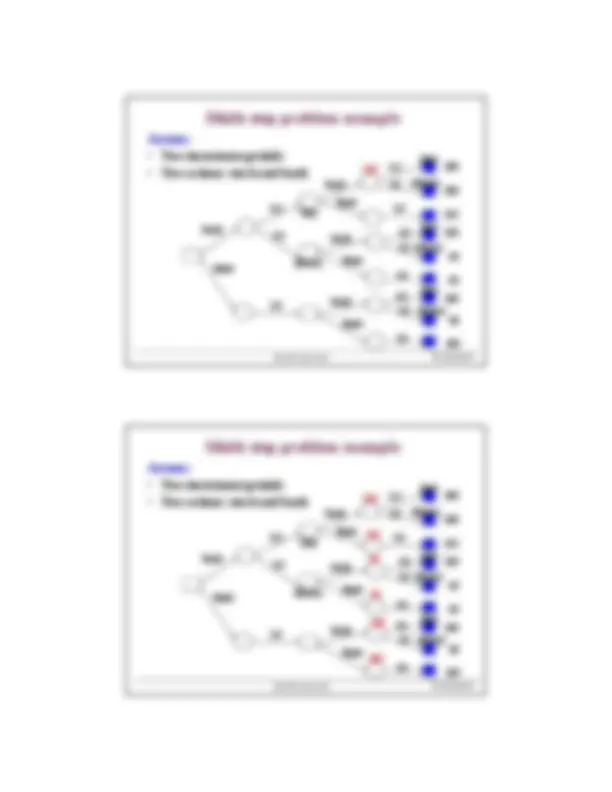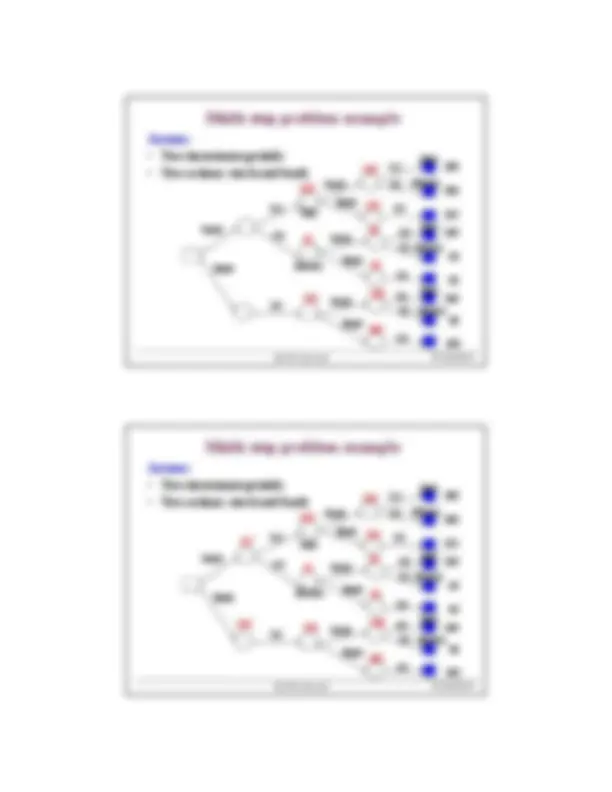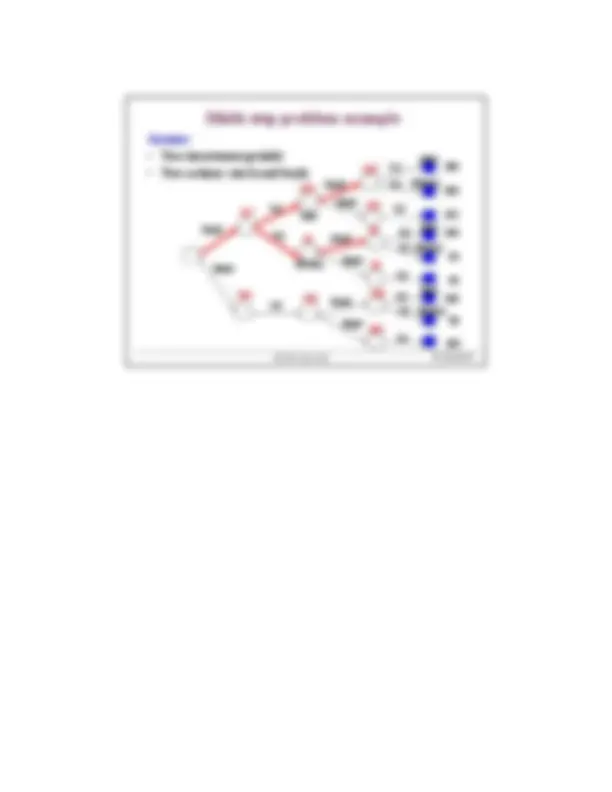Download Monte Carlo Inference and Likelihood Weighting in Probabilistic Reasoning - Prof. Milos Ha and more Assignments Computer Science in PDF only on Docsity!
CS 1571 Intro to AI M. Hauskrecht
CS 1571 Introduction to AI
Lecture 24
Milos Hauskrecht
milos@cs.pitt.edu
5329 Sennott Square
Monte Carlo Inference
Decision making in the presence of
uncertaity
Monte Carlo approaches
- MC approximation :
- The probability is approximated using sample frequencies
- Example:
- BBN sampling:
- One sample gives one assignment of values to all variables
N
N
P ( B = T , J = T )= B^ = T , J = T
# samples with B = T , J = T
total # samples
M
A
B
J
E
Generate sample in a
top down manner, following
the links
CS 1571 Intro to AI M. Hauskrecht
BBN sampling example
Burglary Earthquake
JohnCalls MaryCalls
Alarm
B E T F
T T 0.95 0.
T F 0.94 0.
F T 0.29 0.
F F 0.001 0.
P (B)
P (E)
A T F
T 0.90 0.
F 0.05 0.
A T F
T 0.7 0.
F 0.01 0.
P (A|B,E)
P (J|A) P (M|A)
T F T F
BBN sampling example
Burglary Earthquake
JohnCalls MaryCalls
Alarm
B E T F
T T 0.95 0.
T F 0.94 0.
F T 0.29 0.
F F 0.001 0.
P (B)
P (E)
A T F
T 0.90 0.
F 0.05 0.
A T F
T 0.7 0.
F 0.01 0.
P (A|B,E)
P (J|A) P (M|A)
T F T F
F
CS 1571 Intro to AI M. Hauskrecht
BBN sampling example
Burglary Earthquake
JohnCalls MaryCalls
Alarm
B E T F
T T 0.95 0.
T F 0.94 0.
F T 0.29 0.
F F 0.001 0.
P (B)
P (E)
A T F
T 0.90 0.
F 0.05 0.
A T F
T 0.7 0.
F 0.01 0.
P (A|B,E)
P (J|A) P (M|A)
T F T F
F F
F
F
BBN sampling example
Burglary Earthquake
JohnCalls MaryCalls
Alarm
B E T F
T T 0.95 0.
T F 0.94 0.
F T 0.29 0.
F F 0.001 0.
P (B)
P (E)
A T F
T 0.90 0.
F 0.05 0.
A T F
T 0.7 0.
F 0.01 0.
P (A|B,E)
P (J|A) P (M|A)
T F T F
F F
F
F F
CS 1571 Intro to AI M. Hauskrecht
BBN sampling example
Burglary Earthquake
JohnCalls MaryCalls
Alarm
B E T F
T T 0.95 0.
T F 0.94 0.
F T 0.29 0.
F F 0.001 0.
P (B)
P (E)
A T F
T 0.90 0.
F 0.05 0.
A T F
T 0.7 0.
F 0.01 0.
P (A|B,E)
P (J|A) P(M|A)
T F T F
F F
F
F F
Sample:
F F
F
F F
Monte Carlo approaches
- MC approximation of conditional probabilities :
- The probability is approximated using sample frequencies
- Example:
- Rejection sampling:
- Generate samples from the full joint by sampling BBN
- Use only samples that agree with the condition, the
remaining samples are rejected
- Problem: many samples can be rejected
J T
BTJT
N
N
P B T J T
=
= =
,
# samples with B = T , J = T
# samples withJ = T
CS 1571 Intro to AI M. Hauskrecht
BBN likelihood weighting example
Burglary Earthquake
JohnCalls MaryCalls
Alarm
B E T F
T T 0.95 0.
T F 0.94 0.
F T 0.29 0.
F F 0.001 0.
P (B)
P (E)
A T F
T 0.90 0.
F 0.05 0.
A T F
T 0.7 0.
F 0.01 0.
P (A|B,E)
P (J|A) P (M|A)
T F T F
T F
J = T (set !!!) M = F (set !!!)
BBN likelihood weighting example
Burglary Earthquake
JohnCalls MaryCalls
Alarm
B E T F
T T 0.95 0.
T F 0.94 0.
F T 0.29 0.
F F 0.001 0.
P (B)
P (E)
A T F
T 0.90 0.
F 0.05 0.
A T F
T 0.7 0.
F 0.01 0.
P (A|B,E)
P (J|A) P (M|A)
T F T F
T F
T
J = T (set !!!) M = F (set !!!)
CS 1571 Intro to AI M. Hauskrecht
BBN likelihood weighting example
Burglary Earthquake
JohnCalls MaryCalls
Alarm
B E T F
T T 0.95 0.
T F 0.94 0.
F T 0.29 0.
F F 0.001 0.
P (B)
P (E)
A T F
T 0.90 0.
F 0.05 0.
A T F
T 0.7 0.
F 0.01 0.
P (A|B,E)
P (J|A) P (M|A)
T F T F
T F
T
J = T (set !!!) M = F (set !!!)
BBN likelihood weighting example
Burglary Earthquake
JohnCalls MaryCalls
Alarm
B E T F
T T 0.95 0.
T F 0.94 0.
F T 0.29 0.
F F 0.001 0.
P (B)
P (E)
A T F
T 0.90 0.
F 0.05 0.
A T F
T 0.7 0.
F 0.01 0.
P (A|B,E)
P (J|A) P (M|A)
T F T F
T F
T
J = T (set !!!) M = F (set !!!)
CS 1571 Intro to AI M. Hauskrecht
BBN likelihood weighting example
Burglary Earthquake
JohnCalls MaryCalls
Alarm
B E T F
T T 0.95 0.
T F 0.94 0.
F T 0.29 0.
F F 0.001 0.
P (B)
P (E)
A T F
T 0.90 0.
F 0.05 0.
A T F
T 0.7 0.
F 0.01 0.
P (A|B,E)
P (J|A) P (M|A)
T F T F
F
J = T (set !!!) M = F (set !!!)
Second sample
BBN likelihood weighting example
Burglary Earthquake
JohnCalls MaryCalls
Alarm
B E T F
T T 0.95 0.
T F 0.94 0.
F T 0.29 0.
F F 0.001 0.
P (B)
P (E)
A T F
T 0.90 0.
F 0.05 0.
A T F
T 0.7 0.
F 0.01 0.
P (A|B,E)
P (J|A) P (M|A)
T F T F
F F
J = T (set !!!) M = F (set !!!)
Second sample
CS 1571 Intro to AI M. Hauskrecht
BBN likelihood weighting example
Burglary Earthquake
JohnCalls MaryCalls
Alarm
B E T F
T T 0.95 0.
T F 0.94 0.
F T 0.29 0.
F F 0.001 0.
P (B)
P (E)
A T F
T 0.90 0.
F 0.05 0.
A T F
T 0.7 0.
F 0.01 0.
P (A|B,E)
P (J|A) P (M|A)
T F T F
F F
F
J = T (set !!!) M = F (set !!!)
Second sample
BBN likelihood weighting example
Burglary Earthquake
JohnCalls MaryCalls
Alarm
B E T F
T T 0.95 0.
T F 0.94 0.
F T 0.29 0.
F F 0.001 0.
P (B)
P (E)
A T F
T 0.90 0.
F 0.05 0.
A T F
T 0.7 0.
F 0.01 0.
P (A|B,E)
P (J|A) P (M|A)
T F T F
F F
F
J = T (set !!!) M = F (set !!!)
Second sample
CS 1571 Intro to AI M. Hauskrecht
BBN likelihood weighting example
Burglary Earthquake
JohnCalls MaryCalls
Alarm
B E T F
T T 0.95 0.
T F 0.94 0.
F T 0.29 0.
F F 0.001 0.
P (B)
P (E)
A T F
T 0.90 0.
F 0.05 0.
A T F
T 0.7 0.
F 0.01 0.
P (A|B,E)
P (J|A) P (M|A)
T F T F
F F
F
J = T (set !!!) M = F (set !!!)
0.001 0.999 Earthquake
P (A|B,E)
weight = 0.05*0.99=0.
Evidence J=T,M=F
in combination with B=F,E=F,A=F
Second sample
Likelihood weighting
- Assume we have generated the following M samples:
F F
F
T F
F F
F
T F
T F
F
T F
F F
F
T F
How to make the samples consistent?
Weight each sample by probability with which it agrees with the
conditioning evidence P(e).
M
F F
F
T F
Weight 0.
T F
F
T F
Weight 0.
CS 1571 Intro to AI M. Hauskrecht
Decision-making in the presence of
uncertainty
Decision-making in the presence of
uncertainty
- Computing the probability of some event may not be our
ultimate goal
- Instead we are often interested in making decisions about
our future actions so that we satisfy goals
- Example: medicine
- Diagnosis is typically only the first step
- The ultimate goal is to manage the patient in the best
possible way. Typically many options available:
- Surgery, medication, collect the new info (lab test)
- There is an uncertainty in the outcomes of these
procedures: patient can be improve, get worse or even
die as a result of different management choices.
CS 1571 Intro to AI M. Hauskrecht
Decision making example.
Assume we want to invest $100 for 6 months
1. Invest in Stock 1
2. Invest in Stock 2
3. Put money in bank
4. Keep money at home
Stock 1
Stock 2
Bank Stock 1 value can go up or down :
Up: with probability 0.
Down: with probability 0.
Monetary
Outcomes
for up and
down states
Home
(up)
(down)
Decision making example.
Investing of $100 for 6 months
Stock 1
Stock 2
Bank
Monetary
outcomes
for different
states
Home
(up)
(down)
(up)
(down)
CS 1571 Intro to AI M. Hauskrecht
Decision making example.
We need to make a choice whether to invest in Stock 1 or 2, put
money into bank or keep them at home. But how?
Stock 1
Stock 2
Bank
Monetary
outcomes
for different
scenarios
Home
?
(up)
(down)
(up)
(down)
Decision making example.
Assume the simplified problem with the Bank and Home
choices only.
The result is guaranteed – the outcome is deterministic
What is the rational choice assuming our goal is to make
money?
Bank (^101)
Home
CS 1571 Intro to AI M. Hauskrecht
Decision making. Stochastic outcome
Stock 1
Stock 2
Bank 101
• How to quantify the goodness of the stochastic outcome?
We want to compare it to deterministic and other
stochastic outcomes.
Idea: Use the expected value of the outcome
(up)
(down)
Expected value
Stock 1
• Let X be a random variable representing the monetary
outcome with a discrete set of values.
• Expected value of X is:
Intuition: Expected value summarizes all stochastic
outcomes into a single quantity.
• Example:
• What is the expected value of the outcome of Stock 1
option?
∈Ω
x X
E ( X ) xP ( X x )
Ω X
CS 1571 Intro to AI M. Hauskrecht
Expected value
Stock 1
• Let X be a random variable representing the monetary
outcome with a discrete set of values.
• Expected value of X is:
• Expected value summarizes all stochastic outcomes
into a single quantity
• Example:
Expected value for the outcome of the Stock 1 option is:
∈Ω
x X
E ( X ) xP ( X x )
Ω X
0. 6 × 110 + 0. 4 × 90 = 66 + 36 = 102
Expected values
Investing $100 for 6 months
Stock 1
Stock 2
Bank
Home
× + × =
(up)
(down)
(up)
(down)

